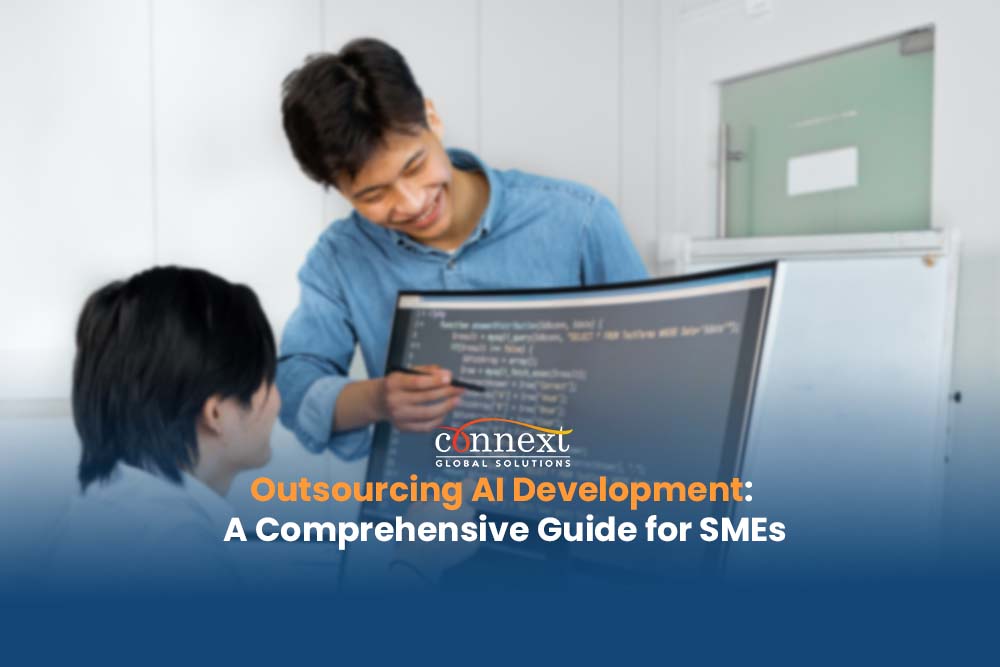Artificial Intelligence (AI) has revolutionized the way businesses operate, and small and medium enterprises (SMEs) are no exception. However, developing AI-based solutions requires specialized skills and technologies, which may not be available in-house. That’s where outsourcing AI development comes into play.
Outsourcing AI Development: A Comprehensive Guide for SMEs
In this article, we’ll explore why outsourcing your company’s AI development projects is a smart idea, the types of AI services you can outsource, best practices in outsourcing AI development, including advice on how to choose the right partner for your outsourcing efforts.

Why outsourcing AI development is a smart idea
Outsourcing AI development offers numerous benefits to SMEs, including:
1. Deployment of personnel can be a lot easier
Building a team of AI developers can be slow and cumbersome which starts from creating a job ad, waiting for applicants, inviting them for interviews, and evaluating whether they fit your company — basically a typical cycle of recruitment and hiring personnel. Afterwards, you need to onboard them and make sure they can jive and work well together. By the time all these are said and done, the time has already passed before the project has even begun.
This is totally not the case when a company chooses to work with an outsourcing development team. In this scenario, your outsourcing service partner can quickly build a team to work on your project as soon as they can. No time is wasted because you won’t have to deal with the lengthy process of recruitment and onboarding.
2. Faster time to market
In business, being the first to launch a certain service or product gives a company an undeniable advantage. An outsourcing development team of AI experts can certainly be of great help in that aspect.
Compared to doing things in-house, outsourcing AI development can accelerate the development process and reduce time to market. That’s because business processing outsourcing companies have the expertise and resources to develop and deliver solutions quickly.
3. Cost-saving
It never hurts to find ways to save money, especially in the case of SMEs and startups where finances are often a concern. If a certain business practice — in this case, outsourcing — saves a company a few bucks then it’s a practice that’s worth considering.
Building an in-house team to work on your company’s AI project, aside from being time-consuming, can be costly and require exhausting the bandwidth of other departments in your company. As such, having an outsourcing AI development team can be more cost-effective than recruiting and building one of your own. In this setup, the outsourcing company takes care of all the expenses associated with hiring and training employees, providing infrastructure, and maintaining equipment.
4. Access to specialized skills and technologies
AI development requires specialized skills and technologies that may not be available in-house, especially for small companies that are often short-staffed. An outsourcing development team with a proven track record of successful projects would certainly be better at handling your company’s AI development project.
With the right partner at the helm, outsourcing AI development enables SMEs to access a team of experts with the needed skills and knowledge.
The main types of AI development services that SMEs can outsource
As AI technologies continue to evolve with time, more and more outsourcing opportunities are quickly developing for SMEs to explore to meet their specific business requirements. Some of the main types of AI development services that SMEs can outsource include:
1. Natural language processing (NLP) services
NLP is a branch of AI enabling machines to generate human language. SMEs can outsource NLP services to develop chatbots, voice assistants, sentiment analysis tools, and other applications that involve natural language processing.
2. Computer vision services
This branch of AI development involves training machines to interpret and analyze visual data from images, videos, and other sources. SMEs can outsource computer vision services to develop applications that involve image recognition, object detection, facial recognition, and other visual analysis tasks.
3. Predictive analytics services
It’s often been said that “data is king.” Data can drive and shape business decisions that’s why this branch of AI development can be very useful for every business, even for SMEs and startups.
That part of AI development is called predictive analytics which involves using AI algorithms to analyze historical data and make predictions about future outcomes. SMEs can outsource predictive analytics services to develop applications that can help them forecast sales, detect fraud, and customer behavior, among others.
4. Robotics process automation (RPA) services
RPA involves automating repetitive and rule-based tasks using software robots. SMEs can outsource RPA services to automate tasks such as data entry, order processing, invoice generation, and other repetitive tasks that can be time-consuming and prone to errors.
5. Machine learning (ML) services
Automating processes is common practice these days. AI, in fact, can be used to develop systems that make operations faster, eliminating the need to have personnel handling those systems.
That’s the main purpose of ML which involves training machines to learn from data and make predictions or decisions without being explicitly programmed. SMEs can outsource ML services to develop applications that can automate decision-making processes, analyze data sets, and make recommendations based on data patterns.
Outsourcing best practices for companies trying out outsourcing AI development for the first time
Outsourcing AI development services can be a game-changer for SMEs trying to compete in the market. However, outsourcing can also be a complex and challenging process, especially for SMEs that are new to outsourcing.
If you are new to this whole practice, here are some best practices for you to remember:
1. Define your requirements clearly
Before outsourcing AI development services, companies who are about to dive into outsourcing and AI development for the first time should define their requirements and expectations clearly. This includes defining the scope of work, project timelines, deliverables, and quality standards. Clear requirements help to avoid misunderstandings and miscommunications that can lead to delays, cost overruns, and project failure.
2. Choose the right outsourcing partner
Shopping for outsourcing vendors? You should choose an outsourcing partner that has relevant expertise, experience, and a proven track record in AI development services. You should also consider factors such as communication skills, cultural fit, and pricing models. You can practice due diligence by checking references, reviewing portfolios, and conducting interviews. Reach out to your prospects and don’t be afraid to ask questions about their services and clear up the things that are maybe unclear to you.
3. Establish clear communication channels
Clear communication is critical for successful outsourcing. Businesses should establish clear communication channels with their outsourcing partner, including project management tools, video conferencing, and email. They should also establish regular communication schedules and provide feedback promptly.
4. Set realistic expectations
It’s important for outsourcing clients to set realistic expectations for outsourcing AI development services. They should understand that outsourcing is not a magic bullet and that there may be challenges and risks involved. They should also be prepared to invest time and resources in the outsourcing process.
5. Protect your intellectual property
Businesses should protect their intellectual property when outsourcing AI development services. This includes signing non-disclosure agreements (NDAs) and ensuring that their outsourcing partner adheres to data security and privacy standards.
6. Monitor project progress
Monitoring project progress closely and regularly ensures your goals for the AI development projects are being met. This includes tracking project milestones, reviewing deliverables, and providing feedback. Monitoring helps to ensure that the project stays on track and meets the defined requirements and quality standards.
7. Evaluate project outcomes
After the outsourcing project is complete, outsourcing clients should evaluate project outcomes objectively. This includes reviewing project deliverables, assessing the quality of work, and analyzing project costs. This would help identify areas for improvement and make informed decisions about future outsourcing projects.
In conclusion, outsourcing AI development services can be a great way for SMEs to access advanced technology and gain a competitive edge in their industry. However, outsourcing can be a complex process, particularly for SMEs trying it out for the first time. By following outsourcing best practices, such as defining requirements clearly, choosing the right outsourcing partner, setting realistic expectations, and protecting intellectual property, SMEs can successfully navigate the outsourcing process and reap the benefits of AI development services. With the right partner and approach, SMEs can outsource AI development to improve their operations and take their business to the next level.
Explore the benefits of strategic leadership in our guide to understanding outsourced CMOs, complementing your knowledge from our comprehensive guide on outsourcing AI development for SMEs.
Outsource to Connext Global Solutions today.
Follow us on:
Facebook: Connext
LinkedIn: Connext
Instagram: @connextglobalsolutions_
Twitter: @ConnextPh
References
Boiko, Oleh. “Artificial Intelligence Outsourcing: How to Get It Right and Boost Your next Project – N-IX.” Software Development Company – N-IX, 3 Oct. 2022, https://www.n-ix.com/ai-outsourcing-how-to-get-it-right/.
Brown, Sara. “Machine Learning, Explained | MIT Sloan.” MIT Sloan, MIT Sloan School of Management, https://mitsloan.mit.edu/ideas-made-to-matter/machine-learning-explained.
Cote, Catherine. “What Is Predictive Analytics? 5 Examples | HBS Online.” Business Insights Blog, 26 Oct. 2021, https://online.hbs.edu/blog/post/predictive-analytics.
Hinson, David, and Rajiv Shenoy. “Higher Education Technology: When to Develop In-House Solutions, and When to Partner with Companies? | EDUCAUSE.” EDUCAUSE Review | EDUCAUSE, https://er.educause.edu/blogs/2019/2/higher-education-technology-when-to-develop-in-house-solutions-and-when-to-partner-with-companies.
Jackson, Paul. “A Rundown on the Different Types of AI for Business Leaders – Velvetech.” Velvetech, 11 Jan. 2022, https://www.velvetech.com/blog/artificial-intelligence-types/.
Malinowski, Kajetan. “Future of the Outsourcing Business in the AI World | News | FOCUS ON Business – Created by Pro Progressio.” FOCUS ON Business, https://www.facebook.com/focusonbusiness.eu, 12 Feb. 2021,https://focusonbusiness.eu/en/news/future-of-the-outsourcing-business-in-the-ai-world/4068.
“What Is Natural Language Processing? | IBM.” IBM – United States, https://www.ibm.com/topics/natural-language-processing.
Expand your SME’s capabilities with strategic outsourcing. Discover the benefits of outsourcing Salesforce in our comprehensive guide, tailored to enhance AI development.









